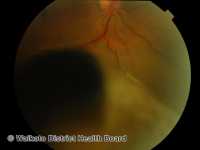
21 May Genes Linked to Melanoma of the Eye Identified
MedicalResearch.com Interview with:

Dr. Brooks
Dr. Kelly Brooks PhD
Research Officer
QIMR Berghofer Medical Research Institute
MedicalResearch.com: What is the background for this study?

An example of uveal melanoma
DermNet NZ image
Response: There are approximately 175 new cases a year for melanomas inside the eye called uveal melanomas. These cancers spread to other sites of the body in about half of patients. Uveal melanomas are very different to skin melanomas and so far no effective treatment have been approved to treat uveal melanoma once it has spread.
We sequenced uveal melanoma tumours from over 100 different patients to look at what mutations are responsible for tumour growth and development.
MedicalResearch.com: What are the main findings?
Response: We found that iris melanomas which make up 5% of uveal melanoma have UV/sun damage and due to this a much higher number of mutations than the majority of uveal melanoma tumours. From other cancer types we know that a higher number of mutations indicates a better response to immunotherapy. This means it is likely that iris melanomas would benefit from this treatment, which is not very effective for the majority of uveal melanomas.
We also found some new mutations not previously observed in uveal melanomas including a common anti-cancer gene TP53. The disruption of this gene and partners it interacts with in uveal melanoma provides some new areas to investigate for developing treatments.
MedicalResearch.com: Are blue eyes more susceptible to melanoma?
Response: Yes, though we don’t really understand why yet, there does seem to be a higher number of uveal melanoma cases in people with light colour irises.
MedicalResearch.com: What should readers take away from your report?
Response: Uveal melanoma is a complex disease and different from skin melanoma. We have made significant progress in identify what genes drive this cancer, providing hope for the future development of treatments for this cancer.
MedicalResearch.com: What recommendations do you have for future research as a result of this work?
Response: We and previous studies have identified a number of genes that play a role in uveal melanoma. We now need to work to understand what these genes are doing to lead to tumour development and how we may be able to stop this and develop treatments for uveal melanoma.
The identification of subsets of uveal melanoma tumours with a high number of mutations means they might respond to immunotherapy. A clinical trial is needed to investigate immunotherapy responses particularly in these uveal melanoma subsets.
Citation:
Johansson, P.A., Brooks, K., Newell, F. et al. Whole genome landscapes of uveal melanoma show an ultraviolet radiation signature in iris tumours. Nat Commun 11, 2408 (2020). https://doi.org/10.1038/s41467-020-16276-8
[subscribe]
[last-modified]
The information on MedicalResearch.com is provided for educational purposes only, and is in no way intended to diagnose, cure, or treat any medical or other condition. Always seek the advice of your physician or other qualified health and ask your doctor any questions you may have regarding a medical condition. In addition to all other limitations and disclaimers in this agreement, service provider and its third party providers disclaim any liability or loss in connection with the content provided on this website.
Last Updated on May 21, 2020 by Marie Benz MD FAAD
